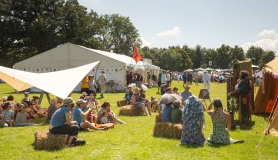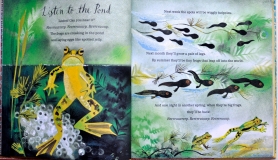Children reach so many milestones in just a few short years such as losing a first tooth, dressing themselves for the first time, learning to swing, to skip or tie shoes. Wearing a special badge is a fun way to help celebrate an achievement or a birthday or simply decorate clothes and hair. Using scraps of felt and some basic stitching makes them fast and super easy to put together.
SUPPLIES Felt scraps, paper and pencil, a biro, six strand embroidery thread (floss), embroidery needle, small scissors, brooch pin or safety pin, cereal box or other card, stuffing (toy stuffing or small scraps of wool) Optional: cocktail stick, ribbon, pinking shears, hair band, glue and clothes pegs
1 Cut out one felt circle that is 5.5cm in diameter or a rectangle that is 4.5cm x 5.5cm. Cut out a second circle or rectangle slightly smaller than the first (about 5mm smaller all the way around). This second shape should be in a contrasting colour (we used pinking shears on this smaller one). Cut out a circle or rectangle from a piece of card, it should be about 5mm smaller all the way around than your smaller, second felt circle or rectangle.
2 Draw a very simple image motif on paper and cut it out, or choose one from our template. A number can be used to make a birthday badge, a star for a special achievement or a heart for extra kindness and love. The image motif should fit inside the slightly smaller circle or rectangle. Lay the motif pattern down on a piece of felt that contrasts with the smaller shape then trace around it with a biro.
Tip: If you’re cutting out numbers, reverse the number before tracing it so that the biro will be on the back of the felt when you stitch it together.
3 Use one or two strands of the six strand embroidery thread and stitch your motif to your smaller felt circle or rectangle.
4 If you want to add a ribbon to the badge cut a piece and stitch it to your backing circle or rectangle. You can fold the top of the ribbon slightly as you stitch it to give the ribbon a little body. Stitch a safety pin or brooch pin above the backing ribbon and slightly above the centre of the badge.
5 Centre your smaller circle or rectangle (the one the motif is stitched to) on top of the backing shape and begin stitching the two shapes together; stop half way around. Slip the piece of card between the two shapes. Before continuing be sure your decoration is complete, we added some stitches to the centre of the star. Continue stitching and leave a gap (about 2cm) unstitched.
6 Gently push some stuffing through the gap into the badge between the piece of card and the top circle or rectangle. When the badge is nicely stuffed sew up the small gap and tie off the stitching at the back of the badge.
ALTERNATIVE Instead of stitching, complete steps four through six using glue (the pin would still need to be stitched to the back of the badge). Hold the glued edges with several clothes pegs while the glue dries and let it dry completely before stuffing. Also, instead of using a pin, try stitching a badge to a hairband to wear on a ponytail.
A STITCH IN TIME There are hundreds of embroidery stitches to try, my favourite is the backstitch but here is a short list of the stitches I use most: the running stitch, backstitch, lazy daisy, split stitch, blanket stitch, chain stitch, satin stitch and French knots. In addition to the running stitch a whipstitch is commonly used for felt appliqué and is the way we applied the star.
Draw your own shapes or go to tinyurl.com/makeownbadges to download a sheet of shape templates, numbers and simple image motifs for the badges.
If you’re new to stitching it’s quick and easy to learn. Imperfect stitching is charming and adds to the handcrafted look so don’t let being a beginner put you off. For reference, look for needlecraft or embroidery books in your local library where there is usually a very good selection. Also look at, Mary Corbet’s Stitch Video Library where you can view “how-to” stitching demonstrations online. needlenthread.com/videos







